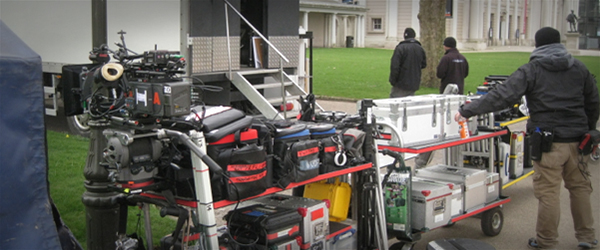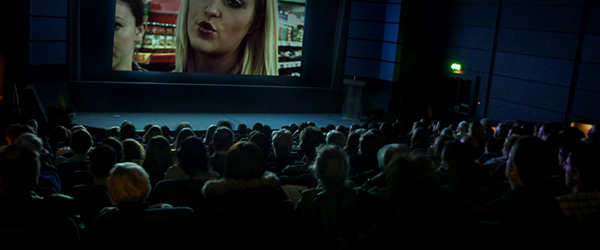Producer’s Etiquette: Learn to Love the Little Things
If you ask the average person to define what a film producer actually does, chances are they’ll have no clue. But ask people in the film industry, and answers will range from “schmoozer” to “control freak” to “solutions provider”. And hopefully you don’t get something like Chili Palmer’s response in Get Shorty: “I don’t think the producer has to know much.”
The latter quote was how Stu Pollard, whose credits include True Adolescents and Ira & Abby, started his “Producer’s Etiquette” panel at the Film Independent offices in Los Angeles on February 23.
In the barest terms, a producer’s job is to make sure a film gets made—and then watched—by any means necessary. Almost any means. Throughout the night, Stu illustrated how, aside from being in charge of the production from start to finish, it’s important for the Producer not to forget the little social niceties that make talent relationships hum, like wedding notes and good Southern manners. In fact, Pollard broke Producer’s Etiquette down into three areas that prove Producing is far from a 9 to 5 job.

PREPARATION
“Do your homework,” said Stu, causing all of us college graduates in the audience to cringe. But he’s right. Dedicating time to learning about the films and filmmakers working their way through festival circuit and securing distribution deals is an important part of learning how to become a success yourself. Even a few clicks on IMDb or LinkedIn can give you a ton of information on the people you can potentially connect with for your projects. So go ahead, indulge in your stalking tendencies. It’s all part of the job.
But while reading into the lives of creators and their films for the sake of the art sounds fun, Pollard’s next advice took an interesting turn. “If you’re not willing to invest a little bit of money in your career, you’re going to get what you paid for.” But again, he’s right. Spending money on an IMDb Pro account or a Directors Close-Up pass? Money. Finding a potential investor or future collaborator in the process? Priceless.

EXPLORATION
This was possibly the shortest part of the session, because if you’re reading this you’ve probably attended a Film Independent event in the past—or will soon—and that’s already a good sign of your explorer side. Film societies, film festivals, film industry blogs and newsletters…if it can bring you to knowledge you didn’t know before about the environment you’ve decided to focus your career on, do it. Here’s a fun one, brought to you by Stu. “Statistically, it’s easier to get into Harvard than it is to Sundance.” The more you know, right?

CONNECTION
Up until this point, you might’ve been able to exercise your producer muscle just by preparing and exploring on your laptop while wearing pajamas. But making connections with other filmmakers in real life is a whole other world.
Let’s say you went to a Member Night at Film Independent a while back and found your cinematic soulmate, whose script you subsequently produced. Awesome! Then you did your research to find some accessible (or semi-accessible) industry person whose support you’d love to have for your project, and you connected on LinkedIn. What’s next? There are three important hurdles to clear:
THE MEETING PREP
“You really should have an entrepreneurial approach to how you represent yourself visually and professionally,” said Pollard. This led to a pretty cool tangent about business cards, which is a good first step to presenting yourself appropriately. However, the work of presentation continues all the way through how you decide to package and pitch your work.
“I have a very particular set of skills—skills I have acquired over a very long career.” Okay, that wasn’t Pollard. That was Liam Neeson. But the first part of preparing for a meeting is to decide what skills or experience you can bring to the table, rather than think you are there to be helped.
Another cool insight was the idea of having three pitches for your film: a one-minute pitch to lay it on the table, a five-minute pitch if they express some interest and a twenty-minute pitch to bring it home.
MEETING
AKA, the first date. Whether you’re having your first general meeting, discussing a script, or talking numbers, never forget to say please and thank you, arrive early, sit up straight, hold their door open, etc. If you’re a “verbal nodder” learn to listen without the “uh-huh” and “right, right”. Pollard particularly stressed the importance of not using your phone. Don’t put it on vibrate, don’t even put it on the table for the 30 minute meeting. You’ll live. Use these seemingly insignificant gestures to show the person you appreciate their time. And since it’s the first date, the goal should be less about a physical outcome and more about what kind of relationship you can build with this person.
THE ART OF THE FOLLOW-UP
When was the last time you wrote a hand-written note? Think how much you’ll stand out to your potential collaborator if they pick up their mail one day and in a pool of bills and useless coupons they find your charming hand-written letter? Pollard recounted how he made sure to send every crewmember a hand-written note within two or three months of wrapping a production. That’s gratitude, ladies and gentlemen.
Wrapping up, Pollard summed up the art of producer’s etiquette by saying, “These things in and of themselves will change your life,” he continued, “Used tactfully and in tandem with one another, [they] can separate you from a lot of people out there who don’t think it matters.”
For more information about upcoming Film Independent events, click here. To learn more about our Film Education program, click here.
Learn how to become a Member of Film Independent by visiting our website and subscribe to our YouTube channel.